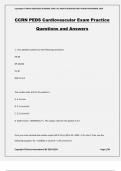Exam (elaborations)
CCRN PEDS Cardiovascular Exam Practice Questions and Answers
CCRN PEDS Cardiovascular Exam Practice
Questions and Answers
1. Your pediatric patient has the following parameters
HR 80
BP 100/60
SV 40
BSA 0.9 m2
The cardiac index (CI) for this patient is
A. 4.4 L/min
B. 3.2 L/min/m2
C. 3.5 L/min/m2
D. 3200 mL/m2 - ANSWER-C. The cardiac index for thi...
[Show more]
Preview 4 out of 38 pages
Uploaded on
November 3, 2024
Number of pages
38
Written in
2024/2025
Type
Exam (elaborations)
Contains
Questions & answers
Institution
CCRN
Course
CCRN
$13.49
Also available in package deal from $82.99
100% satisfaction guarantee
Immediately available after payment
Both online and in PDF
No strings attached
Also available in package deal (1)
$ 193.35
$ 82.99
15 items
1. Exam (elaborations) - Ccrn exam questions and correct answers | a grade
2. Exam (elaborations) - Ccrn peds aacn exam practice questions and answers
3. Exam (elaborations) - Ccrn peds cardiovascular exam practice questions and answers
4. Exam (elaborations) - Ccrn peds cardiovascular exam practice questions and answers
5. Exam (elaborations) - Ccrn practice questions with correct answers
6. Exam (elaborations) - Ccrn practice questions – cardiovascular with correct answers |updated and verified
7. Exam (elaborations) - Barron/elsevier ccrn practice test questions with correct answers
8. Exam (elaborations) - Ccrn question bank neurology with 100% correct answers
9. Exam (elaborations) - Ccrn question bank neurology with correct answers
10. Exam (elaborations) - Ccrn questions with correct answers updated 2024
11. Exam (elaborations) - Ccrn questions with correct answers updated 2025
12. Exam (elaborations) - Neurology ccrn questions with correct answers
13. Exam (elaborations) - Ccrn test bank exam practice questions and answers
14. Exam (elaborations) - Ccrn test bank exam practice questions and answers
15. Exam (elaborations) - Practice test 1 ccrn (pass ccrn) questions and answers 100% pass
Show more
Copyright © KAYLIN 2024/2025 ACADEMIC YEAR. ALL RIGHTS RESERVED FIRST PUBLISH NOVEMBER, 2024




